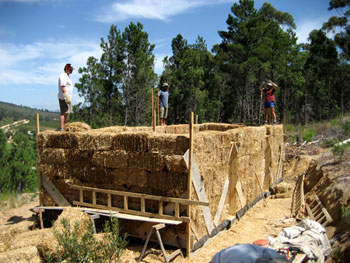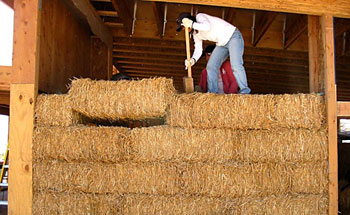GUEST ARTICLE BY MARK BURGUNDER: Most people we talk to about our new strawbale home for the first time look at us as if we’re dumb or simple at first and then invariable ask us:
- Why straw bales?
- Won’t the straw rot?
- What about mice and other pests living in the straw?
- Won’t the straw bales catch fire really easily during a bush fire?
My wife, Rosalba, and I have started the process of building a new Strawbale home where we are currently in the planning stage.
Rosalba runs a successful Acupuncture and Traditional Chinese Medicine clinic in Brisbane and is used to thinking a little differently as part of her business. I, Mark, run Avanti Hosting, a small web hosting company, and feel like I need a little balance in my life from all the new fangled computers, servers, switches, Internet, etc. that form part of my daily life.
So Rosalba and I bought some land at the top of the Mary river valley, about two hours drive from Brisbane, for our ‘back to basics’ urges where we decided to build our new home using straw bales.
In this article I’d like to address the above questions.
Why straw bales?
Straw bales are a renewable resource and most of the straw in Australia is actually burnt on the field. By using straw bales for the walls of our new home we will actually reduce the amount of green house gases released just by the mere fact that the straw we’ll use has not been burnt. Additionally the straw we’ll use will be preserved for many years which means that the carbon contained in the straw will be trapped for quite some time.
Also from what we have read so far the walls of a building make up about 20% of the cost of building a home. Using straw bales you can save quite a bit on the cost of the walls because a) straw bales are cheaper than bricks per square meter, and b) straw bales are easy to stack up to make a wall and lend themselves to be built by the owner. In other words building with straw bales is quite forgiving.
Last but not least, the thickness (up to half a meter) of the straw bale walls makes for a very comfortable home and inspires a feeling of security and being at home.
Won’t the straw rot?
The main thing when building with straw is to keep it dry, not much different from building with timber. There are a few things you can do quite easily to ensure your straw bales don’t get wet.
We intend to build our new home using the infill method, basically have a frame built out of timber or steel that is strong enough to hold up the roof. So we will have the frame erected first and then the roof finished as well. Once the roof is in place, we’ll have the straw bales delivered and will store them under the roof until we use them to build up the roof. This should keep them dry.
Once the straw bale walls are stacked to make up the walls, we will render them using most likely a lime or earthen render as opposed to a cement render. The major advantages we see with the lime render are that it automatically fixes any small cracks by itself and that a lime or earthen render will let the straw bales breathe. This breathing ensures no excessive moisture is trapped in the straw bale walls.
Some straw bale houses are over 100 years old. See Australasian Straw Bale Building Association FAQ
What about mice and other pests living in the straw?
Once the walls have been rendered there is no way in (or out) for mice and other pests. Any creatures trapped in our straw bale walls will most likely die of thirst.
Also it is important to ensure that you build with straw and not hay. Straw is the left over stalks of wheat, rice or other grains after harvest and has vary little nutritional value for any creature. Hay on the other hand is grass that has been cut and slightly dried with the seeds still attached. Hay is generally used as fodder for live stock so it has quite a lot of nutrition contained within it.
Another interesting fact is that most termites will not eat straw. See Strawtec FAQ (Termites/Rodents/Insects) and Brian Hodge author of “Building Your Straw Bale Home published by CSIRO publishing”.
You can buy the book directly from the Author or from Amazon.com
Won’t straw bale walls catch fire really easily during a bush fire?
Once the straw bales have been stacked up to make the walls they are then compressed and rendered to finish off the wall. After this has been done there is very little oxygen left in the straw bales which gives a finished straw bale wall the ability to withstand bush fires astonishingly well.
The CSIRO performed some tests in 2002 with rendered straw bale walls where all involved where surprised and impressed by the excellent performance the straw bales displayed during the fire tests. Also in tests performed in America the fire resistance of rendered straw bales was found to be 2 hours compared to a timber framed and cladded building only achieving a fire rating of 8 minutes. This shows that straw bale walls are quite safe even in bush fire areas. See Strawtec FAQ (Fire) and Australasian Straw Bale Building Association FAQ
To sum up, Rosalba and I are building our new home using straw bales because of the environmental benefits, because we can easily get involved with the actual building ourselves, and because of the increased comfort offered by straw bale buildings compared to standard built homes.
Strawbale House – Useful Links
- To follow the progress of our straw bale home check out my Strawbale House blog or subscribe to my Strawbale House RSS Feed
- The Australasian Straw Bale Building Association
- Brian Hodge (Australian Strawbale House Expert) – Workshops and Advisory service (Heathcote, Victoria)
- “Building Your Straw Bale Home” book – Buy it directly from the Author or from Amazon.com
- Unicorn House Architecture & Building – Energy Efficient and Environmentally Sustainable Design and Building firm (Daylesford, Victoria)
- Huff ‘n’ Puff Strawbale Constructions (Ganmain, NSW)
This guide to building Strawbale Houses has been written by my friend Mark Burgunder.
If you’re a blogger or an expert about a topic I cover on this blog I encourage you to contact me and I’ll consider publishing your guest article here including generous attribution and back links back to your website as thanks for your contribution



Leave a Reply